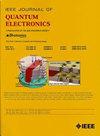Numerical Investigation of 1662 nm Holmium-Doped Fiber Lasers Enabled by a 751 nm Fiber Laser Pump
IF 2.1
3区 工程技术
Q3 ENGINEERING, ELECTRICAL & ELECTRONIC
引用次数: 0
Abstract
In this study, we present a novel fiber laser that employs self-pumping from internal laser transitions to induce inversion in other transitions. Using the751 nm光纤激光泵浦驱动1662 nm掺钬光纤激光器的数值研究
在这项研究中,我们提出了一种新型光纤激光器,利用内部激光跃迁的自抽运来诱导其他跃迁的反转。利用${}^{5}\mathrm{F}_{4} + ^{5}$ S $_{2}\to ^{5}$ I5激光跃迁在1354 nm填充5I5能级,研究了掺Ho3+的ZrF4 (Ho3+: ZrF4)光纤中1662 nm (${}^{5}\mathrm{I}_{5}\to ^{5}$ I7)的级联激光振荡。采用包含实验光谱参数的八能级速率方程系统对751 nm光纤激光器抽运的级联激光器进行了建模,确定了实际设计方案。利用掺杂浓度为0.1 mol.%的1.3 m长的Ho3+: ZrF4光纤,假设泵浦功率为10 W发射到光纤芯部,仿真结果表明,该级联系统的斜率效率为38.9%,最大输出功率为2.94 W。该结果促进了基于市售ZrF4光纤的1662 nm光纤激光器的开发。该激光器具有多种应用潜力,包括电信、气体传感、多光子荧光显微镜和泵源。
本文章由计算机程序翻译,如有差异,请以英文原文为准。
求助全文
约1分钟内获得全文
求助全文
来源期刊

IEEE Journal of Quantum Electronics
工程技术-工程:电子与电气
CiteScore
4.70
自引率
4.00%
发文量
99
审稿时长
3.0 months
期刊介绍:
The IEEE Journal of Quantum Electronics is dedicated to the publication of manuscripts reporting novel experimental or theoretical results in the broad field of the science and technology of quantum electronics. The Journal comprises original contributions, both regular papers and letters, describing significant advances in the understanding of quantum electronics phenomena or the demonstration of new devices, systems, or applications. Manuscripts reporting new developments in systems and applications must emphasize quantum electronics principles or devices. The scope of JQE encompasses the generation, propagation, detection, and application of coherent electromagnetic radiation having wavelengths below one millimeter (i.e., in the submillimeter, infrared, visible, ultraviolet, etc., regions). Whether the focus of a manuscript is a quantum-electronic device or phenomenon, the critical factor in the editorial review of a manuscript is the potential impact of the results presented on continuing research in the field or on advancing the technological base of quantum electronics.
 求助内容:
求助内容: 应助结果提醒方式:
应助结果提醒方式:


